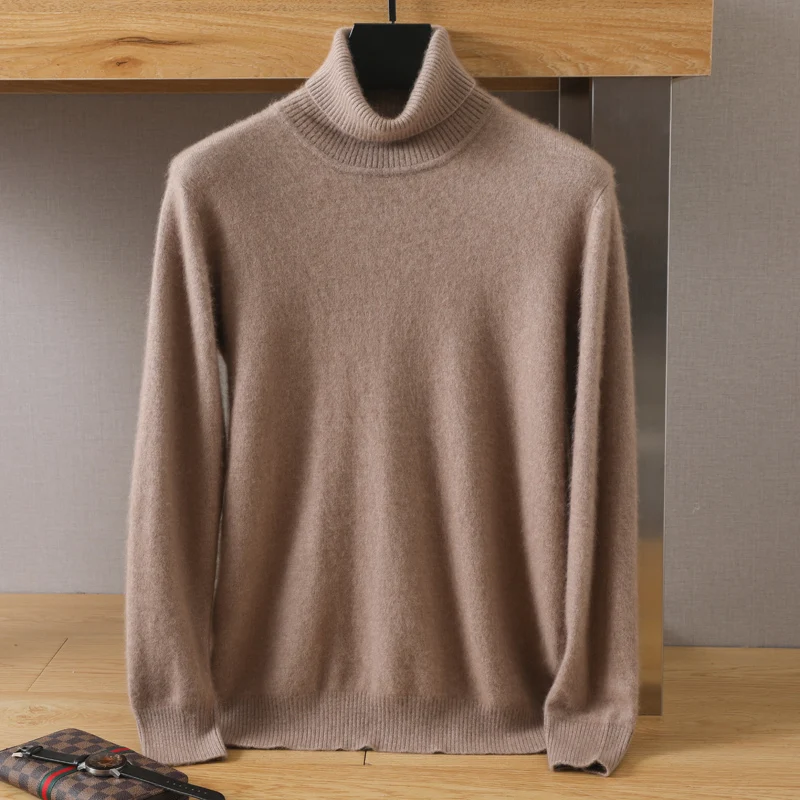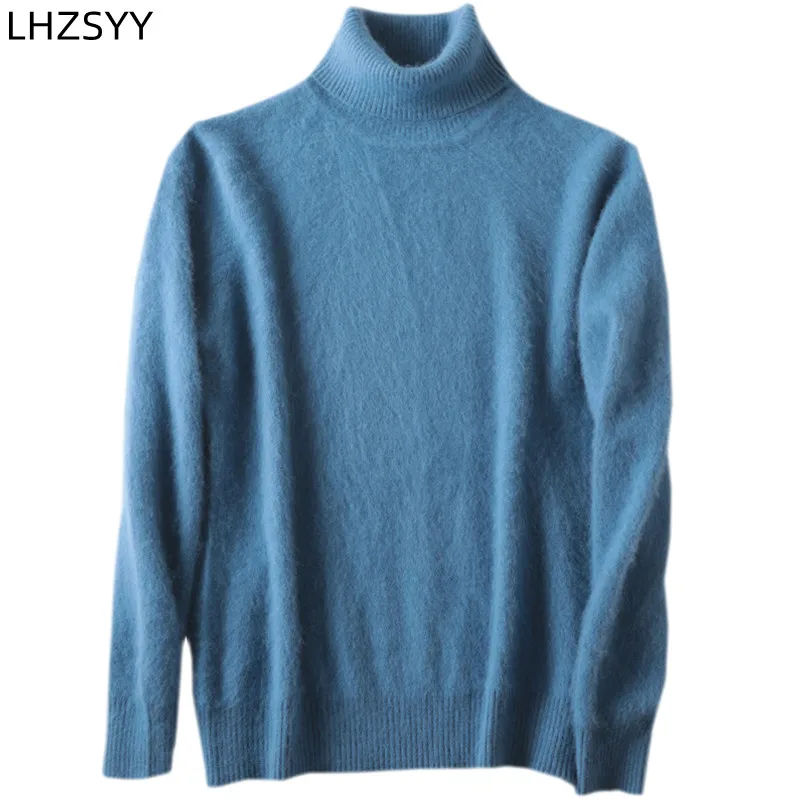Introduction: Cashmere Quality – Beyond Regional Stereotypes
The moment you touch genuine premium cashmere, you understand its allure. That incomparable softness, delicate warmth, and subtle luxurious weight against your skin create an immediate sensory experience that few other materials can match. Yet when shopping for cashmere, you’ve likely encountered conflicting messages about which origin produces the “best” quality—with Mongolian and Scottish cashmere often positioned as opposites on the quality spectrum.
The truth is far more nuanced than simple geographic labels suggest. While origin certainly plays a role in cashmere quality, it’s just one factor in a complex production journey that transforms goat undercoat into the luxurious garments we cherish. Understanding this distinction is crucial for making informed purchasing decisions.
Today’s global cashmere ecosystem operates on a continuum where raw materials from one region often undergo processing in another. Premium cashmere represents a harmonious marriage between exceptional raw fibers and masterful manufacturing—regardless of where each step occurs.
In this comprehensive guide, we’ll examine what truly defines cashmere quality beyond regional stereotypes. You’ll discover the objective indicators of excellence in cashmere sweaters and learn how both Mongolian and Scottish cashmere achieve their distinctive reputations. Most importantly, you’ll gain practical knowledge to evaluate cashmere quality on your own, ensuring every purchase delivers the exceptional experience this luxury fiber promises.
What Determines Cashmere Quality: The Essential Factors
Before comparing Mongolian and Scottish cashmere directly, we must understand the fundamental quality indicators that apply universally. These objective standards provide the framework for evaluating any cashmere garment, regardless of origin.
1. Fiber Diameter (Micron Count):
- Grade A cashmere: 14-16.5 microns (finest, softest fibers)
- Grade B cashmere: 16.6-19 microns (good quality but slightly less fine)
- Grade C cashmere: 19+ microns (coarser feel, more prone to pilling)
The micron count directly impacts how the cashmere feels against your skin. Lower numbers indicate finer fibers, which create that buttery-soft sensation premium cashmere is known for. This microscopic measurement is perhaps the single most important determinant of quality and significantly affects how the garment will feel, drape, and wear over time.
2. Fiber Length:
- Premium length: 36mm+ (exceptional durability and reduced pilling)
- Standard length: 28-35mm (good quality but variable performance)
- Short fibers: Under 28mm (more susceptible to pilling and wear)
Longer fibers can be twisted together more effectively during spinning, creating stronger, more resilient yarn. This translates directly to garments that maintain their appearance longer and resist the pilling that affects cashmere garments with shorter fibers. When evaluating cashmere quality, fiber length is often as important as diameter but receives less attention in marketing materials.
3. Ply and Construction:
- Single-ply: Lighter, more delicate drape, suitable for warmer climates
- Two-ply: Balanced warmth and durability, most versatile construction
- Multi-ply (3+): Maximum warmth and longevity, heavier feel
The number of yarn strands twisted together to create the final thread significantly impacts a garment’s performance characteristics. Higher ply counts generally indicate more substantial construction and better durability, though not necessarily higher fiber quality. The relationship between cashmere gauge and knit density also plays a crucial role in the garment’s final properties.
4. Processing Excellence:
- De-hairing: Removal of coarse guard hairs from soft undercoat
- Cleaning: Elimination of impurities without damaging fibers
- Spinning: Creating yarn with optimal tension and twist
- Knitting/Weaving: Constructing fabric with appropriate tension and density
- Finishing: Final treatments that enhance softness and appearance
Even the finest raw materials can be compromised by subpar processing. Conversely, exceptional manufacturing can maximize the potential of good (though not exceptional) raw fiber. This processing expertise represents the critical value that countries like Scotland bring to the cashmere production chain.
Mongolian Cashmere: Exceptional Raw Materials
Mongolia has earned its reputation as the world’s premier source of raw cashmere fiber through a unique combination of environmental factors, traditional practices, and the specific breeds of cashmere goats that thrive there. Understanding these elements helps explain why Mongolian cashmere holds such an esteemed position in the luxury fiber market.

The Unique Environment
The harsh climate of the Mongolian plateau creates ideal conditions for producing exceptional cashmere. Winter temperatures regularly plunge to -40°F (-40°C), forcing cashmere goats to develop extraordinarily fine, dense undercoats for survival. This natural adaptation creates fibers with exceptional insulating properties at minimal weight—precisely the characteristics that make cashmere so prized.
The semi-desert grasslands also provide a specific diet of native plants that contributes to fiber development. These environmental extremes create what many consider the perfect natural laboratory for premium cashmere fiber production.
Distinctive Fiber Properties
Mongolian cashmere is renowned for its exceptional fineness, often measuring between 14-16 microns in diameter—well within the premium Grade A classification. This natural fineness translates directly to the incredibly soft hand-feel that distinguishes high-quality women’s cashmere pullovers and other garments.
Beyond fineness, Mongolian cashmere exhibits excellent length (typically 36-42mm for premium fibers) and remarkable tensile strength despite its delicacy. These characteristics create finished products with an outstanding balance of luxurious softness and practical durability.
From Tradition to Modern Production
Mongolia’s nomadic herding traditions have evolved over centuries to optimize cashmere quality. Spring harvesting through careful combing (rather than shearing) preserves fiber length and quality. Herders typically collect just 150-200 grams of downy undercoat from each goat annually—a modest yield that highlights cashmere’s precious nature.
While Mongolia produces approximately one-third of the global raw cashmere supply, historically most of this precious resource was exported for processing elsewhere. More recently, Mongolia has been developing domestic manufacturing capabilities, aiming to capture more value from their exceptional raw materials through finished goods production.
This evolution positions Mongolia as both the world’s premium raw fiber source and an emerging manufacturer—a development that’s beginning to challenge traditional assumptions about where the best finished cashmere products originate. The country’s natural advantages for styling cashmere cardigan versatile looks and other finished goods are increasingly being recognized globally.
Scottish Cashmere: The Pinnacle of Manufacturing Expertise
While Mongolia excels in raw fiber production, Scotland has established itself as a global leader in cashmere manufacturing excellence through centuries of textile expertise. Scottish cashmere’s distinguished reputation stems primarily from exceptional processing techniques and rigorous quality standards that transform raw fiber into garments of extraordinary refinement.

Heritage of Excellence
Scotland’s cashmere industry developed in the Borders region, with towns like Hawick becoming synonymous with luxury knitwear. Dating back generations, family-owned mills developed proprietary techniques that have been preserved and refined over time. This intergenerational transfer of knowledge created a concentration of expertise that few other regions can match.
The Scottish industry built its reputation on uncompromising standards, with many manufacturers still employing techniques that prioritize quality over production speed. This commitment to excellence remains evident in the exceptional consistency and refinement of Scottish cashmere garments.
Signature Processing Techniques
Perhaps Scotland’s most significant advantage lies in its water—specifically, the extraordinarily soft water from local rivers. This natural resource proves invaluable during washing and dyeing processes, allowing fibers to be thoroughly cleaned without harsh chemicals that could damage delicate cashmere strands.
Scottish spinning techniques also distinguish their production. Using traditional methods that apply precise tension, Scottish mills create yarns with optimal twist that balances strength with softness. These specialized techniques directly influence how garments like cashmere turtlenecks perform over their lifetime.
The finishing processes further differentiate Scottish cashmere. Garments undergo meticulous treatments that enhance natural softness while removing any remaining guard hairs. The result is cashmere with an exceptionally clean hand-feel and refined appearance that maintains its quality through years of wear.
Raw Material Sourcing
It’s important to understand that Scottish manufacturers typically don’t produce raw cashmere fiber domestically. Instead, they import premium raw materials—often from Mongolia and other Asian sources—and apply their manufacturing expertise to these fibers.
Scottish producers are known for their stringent selection criteria when sourcing raw materials. Many maintain long-standing relationships with specific herding communities and apply rigorous testing to ensure only fibers meeting their exacting standards enter production. This careful sourcing forms the foundation upon which Scottish manufacturing excellence builds.
Finished Product Excellence
The true hallmark of Scottish cashmere lies in its extraordinary consistency and refined characteristics. Garments typically exhibit exceptional durability, superior resistance to pilling, and a distinctive hand-feel that combines softness with structural integrity. These qualities make Scottish cashmere especially well-suited for creating stylish ways to wear cashmere cardigans that maintain their appearance through years of use.
Scottish cashmere also tends to improve with proper care, developing a subtle patina while maintaining structural integrity—a testament to the quality of both the selected raw materials and the manufacturing processes applied.
Mongolian vs Scottish: A Direct Quality Comparison
Having examined the distinctive strengths of both Mongolian and Scottish cashmere, let’s compare them directly across key quality dimensions. This comparison helps clarify that each excels in different aspects of the production chain, creating complementary rather than competing advantages.

| Quality Factor | Mongolian Cashmere | Scottish Cashmere |
|---|---|---|
| Primary Strength | Raw fiber excellence | Manufacturing expertise |
| Fiber Source | Domestic goat herds adapted to extreme climate | Imported raw fiber (often from Mongolia and other Asian regions) |
| Typical Fiber Diameter | 14-16 microns (premium grade) | Variable based on sourcing (premium Scottish products typically use fibers in the 14-16 micron range) |
| Fiber Length | Typically 36-42mm for premium fibers | Variable based on sourcing (premium products use longer fibers) |
| Processing Standards | Historically variable but improving with modernization | Exceptionally consistent with multi-stage quality control |
| Consistency | Natural variation between herds and regions | High uniformity across production due to rigorous standards |
| Pilling Resistance | Variable depending on processing quality | Generally excellent due to meticulous yarn construction |
| Color Retention | Variable depending on dyeing expertise | Exceptional due to specialized dyeing processes |
| Distinctive Qualities | Exceptional natural softness and warmth-to-weight ratio | Refined hand-feel with balanced softness and structure |
This comparison reveals the complementary nature of Mongolian and Scottish contributions to premium cashmere. The finest brushed cashmere sweaters often represent a synthesis of Mongolian fiber quality and Scottish (or similar high-standard) manufacturing expertise.
It’s worth noting that both sources can produce exceptional finished products when the entire production chain maintains high standards. Increasingly, some Mongolian manufacturers are developing expertise that rivals European production, while Scottish manufacturers continue to source the finest raw materials regardless of origin.
The value proposition differs slightly between sources. Mongolian-finished cashmere often offers exceptional raw material quality, sometimes at more accessible price points due to lower manufacturing costs. Scottish cashmere typically commands premium pricing that reflects both excellent raw materials and the additional cost of traditional European manufacturing, justified by exceptional consistency and refinement in the finished product.
When evaluating whether cashmere cardigans are worth investment, understanding these distinctions helps consumers make choices aligned with their specific priorities.
Common Misconceptions About Cashmere Origin and Quality
The cashmere market is rife with oversimplifications and misconceptions about how geography relates to quality. Addressing these myths helps consumers make more informed decisions based on specific quality indicators rather than broad geographic generalizations.
Myth: “Mongolian cashmere is lower quality than European cashmere”
Reality: This misconception confuses raw material quality with manufacturing expertise. Mongolia produces some of the world’s finest raw cashmere fibers—the essential foundation for any quality garment. However, historically, most Mongolian fiber was exported for processing elsewhere, leading to variable quality in domestically-produced finished goods.
Today’s reality is more complex. While some Mongolian-produced garments may lack the refinement of Scottish or Italian production, others—particularly from modern facilities employing skilled technicians—can rival European quality while benefiting from direct access to premium raw materials. Quality varies significantly among producers within any region, making broad generalizations increasingly misleading.
Myth: “Scottish cashmere comes from Scottish goats”
Reality: Scotland has no significant domestic cashmere goat population. Scottish cashmere products are manufactured in Scotland using imported raw fiber—often from Mongolia, China, and other Asian sources. The “Scottish” designation refers to manufacturing location and expertise rather than fiber origin.
This clarification doesn’t diminish Scottish cashmere’s quality; rather, it highlights the global nature of premium cashmere production. The finest men’s cashmere pullovers often represent an international collaboration where the best raw materials meet exceptional manufacturing expertise.
Myth: “Origin alone determines quality”
Reality: While origin influences certain characteristics, multiple factors throughout the production chain determine a garment’s ultimate quality. These include:
- Raw fiber selection (diameter, length, cleanliness)
- De-hairing effectiveness
- Spinning technique and yarn construction
- Knitting or weaving precision
- Finishing processes
- Quality control standards
Two garments using identical raw fiber can differ dramatically in quality based on these manufacturing variables. Likewise, exceptional manufacturing can’t fully compensate for mediocre raw materials. The best products excel across all production stages, regardless of geographic labels.
Myth: “All cashmere from a single region is equal in quality”
Reality: Enormous quality variation exists within any geographic category. Just as wine quality varies dramatically between producers in the same region, cashmere quality depends more on specific producer standards than broad geographic origin.
When layering cashmere cardigans or other garments, understanding these specific quality indicators provides far more useful information than relying on geographic stereotypes. The most reliable approach is evaluating individual garments based on objective quality indicators rather than making assumptions based solely on origin claims.
How to Identify High-Quality Cashmere: A Practical Guide
With a clear understanding of what creates cashmere quality, you can confidently evaluate garments regardless of origin. These practical assessment techniques help identify truly premium cashmere worth investing in.

The Touch Test
Quality cashmere offers a distinctive tactile experience that’s difficult to counterfeit:
Initial feel: Premium cashmere feels incredibly soft but not slippery. Be wary of garments with an unnaturally slick feel, which often indicates silicone treatment—a temporary coating that masks inferior fiber quality and disappears after washing.
Temperature response: Quality cashmere warms quickly to body temperature. Place the fabric against your neck or inner wrist—premium cashmere creates immediate, gentle warmth while maintaining breathability.
Recovery test: Gently stretch the fabric and observe its recovery. Quality cashmere returns to shape quickly without sagging or distortion, indicating proper fiber length and construction.
Visual Inspection
Careful visual assessment reveals important quality indicators:
Weave density: Hold the garment up to light. Premium cashmere has a tight, even weave with minimal light penetration. Loose, uneven weaves suggest inferior construction that won’t wear well over time.
Surface evaluation: Quality cashmere has a clean, even surface with minimal visible fibers. Excessive fuzziness before wearing indicates shorter fibers that will likely pill quickly.
Color consistency: Examine the garment in natural light. Premium cashmere exhibits even coloration without blotchiness or streaking, indicating superior dyeing techniques and fiber quality.
Performance Assessment
These simple tests help predict how the garment will perform over time:
Bounce test: Squeeze a section of the garment and release. Quality cashmere springs back immediately, while inferior products remain compressed or recover slowly.
Pilling potential: Gently rub the surface with your palm for 10-15 seconds. Immediate pilling or fiber shedding suggests shorter fibers that will deteriorate quickly with regular wear.
Weight assessment: Quality cashmere has substantial weight relative to its apparent thickness. Exceptionally light garments that appear thick often contain filler fibers or air-spun yarn that won’t maintain their structure over time.
Women’s cashmere turtlenecks and other premium garments should pass these assessments easily, demonstrating the quality that justifies their investment.
Label and Documentation
Understanding product labeling provides valuable quality insights:
Fiber composition: Pure cashmere should be labeled “100% cashmere.” Be wary of vague terms like “cashmere blend” without specific percentage breakdowns.
Ply information: Quality producers often specify “2-ply” or higher, indicating multiple yarn strands twisted together for greater durability.
Grade disclosure: Premium producers may indicate “Grade A” cashmere, signifying fibers under 16.5 microns. However, absence of this claim doesn’t necessarily indicate lower quality, as grading terminology isn’t universally standardized.
Brand Research
Reputable brands demonstrate commitment to quality through:
Transparency: Quality-focused brands willingly share specific information about their fiber sourcing, processing methods, and quality standards.
Manufacturing details: Premium producers often highlight their manufacturing locations and techniques, particularly if they employ traditional methods or specialized expertise.
Longevity commitment: Brands confident in their quality typically offer detailed care instructions and may provide repair services—indicating they expect garments to remain in use for many years.
These assessment techniques help identify truly exceptional cashmere that will provide years of enjoyment, particularly when mastering how to wear long cashmere cardigans and other investment pieces.
Proper Care: Preserving Your Cashmere Investment
Quality cashmere can last for decades with proper care. These maintenance practices help preserve your garment’s luxurious qualities regardless of origin.
Washing Guidelines:
* Hand wash using lukewarm water (about 85°F/30°C) and mild detergent specifically formulated for wool or cashmere
* Gently squeeze water through the garment without rubbing, wringing, or twisting
* Rinse thoroughly with lukewarm water until all soap residue is removed
* Press (don’t wring) to remove excess water
Drying and Reshaping:
* Lay flat on a clean, dry towel and roll to absorb moisture
* Transfer to a fresh towel and reshape while damp
* Dry flat on a mesh rack or towel away from direct heat and sunlight
* Allow complete drying before folding or wearing (typically 24-48 hours)
Storage Solutions:
* Clean before storing for extended periods
* Fold neatly rather than hanging to prevent shoulder stretching
* Store in breathable cotton bags or acid-free tissue paper
* Include cedar blocks or lavender sachets as natural moth deterrents
* Keep in a cool, dry place away from direct sunlight
Addressing Pills and Wear:
* Remove pills using a cashmere comb or specialized de-pilling tool
* Use gentle, short strokes in one direction
* Address pilling promptly before it affects surrounding fibers
* Seek professional cleaning for stains or extensive refreshing
Proper care significantly enhances the inherent quality of premium cashmere, making it increasingly soft and comfortable over time. This care approach helps maintain the drape and appearance that make lightweight cashmere cardigans and other styles so versatile across seasons and occasions.

Cashmere Wrap Sweaters, Women's Cashmere Pullovers
$75.89 Select options This product has multiple variants. The options may be chosen on the product pageCashmere Cable Knit Sweaters, Women's Cashmere Pullovers
Price range: $111.82 through $112.93 Select options This product has multiple variants. The options may be chosen on the product pageCropped Cashmere Sweaters, Women's Cashmere Pullovers
$155.77 Select options This product has multiple variants. The options may be chosen on the product pageOversized Cashmere Sweaters, Plus Size Cashmere Sweaters, Women's V-Neck Cashmere Sweaters
$136.87 Select options This product has multiple variants. The options may be chosen on the product page- Price range: $108.11 through $130.03 Select options This product has multiple variants. The options may be chosen on the product page
Striped Cashmere Sweaters, Women's Cashmere Pullovers
$139.68 Select options This product has multiple variants. The options may be chosen on the product page
Beyond Origin: Making an Informed Cashmere Purchase
As we’ve explored throughout this guide, truly understanding cashmere quality requires looking beyond simplistic geographic labels to the specific characteristics that determine performance, feel, and longevity.
Both Mongolian and Scottish cashmere offer distinctive advantages. Mongolian cashmere excels in raw material quality due to ideal environmental conditions and traditional herding practices. Scottish cashmere distinguishes itself through exceptional manufacturing expertise developed over generations, transforming fine raw materials into refined finished products.
Rather than asking whether Mongolian or Scottish cashmere is “better,” consider what specific qualities matter most for your needs and preferences. The finest cashmere garments often represent a synthesis of premium raw materials and exceptional manufacturing—regardless of which geographic labels they carry.
When evaluating cashmere, focus on tangible quality indicators:
* Fiber fineness (under 16.5 microns for premium quality)
* Fiber length (longer fibers for durability)
* Construction details (tight, even knitting)
* Handle and performance (soft yet resilient)
These characteristics provide far more reliable guidance than broad geographic generalizations, helping you select pieces that will provide genuine luxury and lasting value, whether you’re exploring versatile outfit ideas for cashmere cardigans or other styling options.
Is Cashmere Always Worth the Investment?
Quality cashmere represents a significant investment, raising reasonable questions about value and alternatives. Consider these perspectives when determining if premium cashmere aligns with your priorities.
Long-term Value Assessment
Premium cashmere offers exceptional longevity when properly maintained. While the initial purchase price may be substantial, the cost-per-wear often proves lower than less expensive alternatives that require frequent replacement. A well-made cashmere garment can remain in active rotation for 10+ years, developing increased softness and character over time.
Unlike trendy items that quickly look dated, classic cashmere designs like women’s cashmere cardigans maintain their relevance across changing fashion cycles. This timelessness further enhances their long-term value, making quality cashmere a genuine investment rather than merely an expense.
Sustainability Perspectives
Durability represents an often-overlooked sustainability factor. Garments that remain in use for many years reduce the environmental impact of frequent replacement. The finest cashmere exemplifies this “buy less, buy better” approach to sustainable consumption.
However, cashmere production does raise environmental and ethical considerations. The increasing global demand has led to larger herds in some regions, potentially contributing to overgrazing and desertification. Responsible producers address these concerns through sustainable herding practices and environmental stewardship programs.
When evaluating cashmere’s sustainability, consider both production methods and the garment’s expected lifespan. Truly sustainable cashmere combines responsible production with exceptional durability.
Alternatives Worth Considering
For those seeking alternatives to pure cashmere while maintaining quality, several options merit consideration:
Premium wool: Fine merino wool (17.5-19.5 microns) offers excellent softness and performance at a lower price point than cashmere. While not quite matching cashmere’s luxurious hand-feel, premium wool provides outstanding durability and value.
Cashmere blends: Quality cashmere wool cardigans and other blended garments can provide excellent performance with enhanced durability and reduced cost compared to pure cashmere. Look for blends with at least 30% cashmere content to maintain luxurious characteristics.
Other luxury fibers: Fibers like alpaca and yak wool offer distinctive qualities that may align with specific preferences. Each has unique characteristics worth exploring as alternatives or complements to cashmere in a well-curated wardrobe.
The ultimate question isn’t whether cashmere is universally “worth it,” but whether specific cashmere pieces align with your individual priorities, budget, and lifestyle. When selected thoughtfully based on objective quality indicators rather than marketing claims, premium cashmere—whether Mongolian, Scottish, or a combination of both—often justifies its investment through exceptional performance and enduring pleasure.
At Estate Cloth, we believe that understanding these nuances helps consumers make more confident, informed decisions about their cashmere purchases. By focusing on specific quality indicators rather than geographic generalizations, you can select pieces that provide genuine luxury and lasting value.







